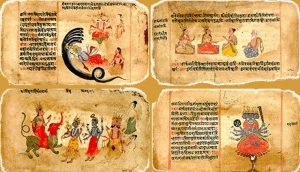Table of Vedas and their Branches
As set out by Sri V.A.K. Ayer
| Vedas | Rig Veda | Krishna Yajur Veda | Sukla Yajur Veda | Samaveda | Atharva Veda |
| No of original Recensions | 21 | 85 | 17 | 101 | 9 |
| Available Recensions or Shakas | Shakala | Taitreeya Mitrayani Katha Kapisthala Swetaswetara | Kanva, Madyandina (Vajasanya) |
Kauthuma, Ranaayaneeya, Jaimineeya |
Pippalada Saunaka |
| Brahmanas | Aitaraya, Kaushitiki (or Shankhyayana) | Taittireeya (Samhita) Taitireeya |
Sathapatha | Panchavimsa, Shadvimsa, Samavidhana, Aarsheya, Mantra, Devatadhyaya, Vamsa, Jaimineeya |
Gopatha |
| Aranyakas | Aitaraya, Sankhyayana |
Taittireeya (Samhita) Taitireeya |
Sathapatha | Panchavimsa, Shadvimsa, Samavidhana, Aarsheya, Mantra, Devatadhyaya, Vamsa, Jaimineeya |
Gopatha |
| Upanishads | Aitaraya, Kaushitiki, Bhashkala |
Aitaraya, Mahanarayana, Mitrayani, Katakha, Swetaswetara |
Isavasya, Brihadaranyaka |
Chandogya, Kena |
Prasna, Mundaka, Mandukya |
| Shrouta Sutras | Aswalayana, Shankhyayana |
Apasthamba, Baudhayana, Hiranyakesi, Bharadwaja, Vaikhanasa, Vadhoola, Manava, Varaha |
Katyayana (Paaraskara) |
Khadira, Latyayana, Drahyayana, Jaimineeya |
Vikhanasa |
| Grihya Sutras | Ashwalayana, Shankyayana |
Ashwalayana, Shankyayana |
Kaatyayana (Paaraskara) |
Kadira, Gobhila, Gautama, Jaimineeya |
Kaushika |
| Dharma Sutras | Vasishtha | Apasthamba Baudhayana Hiranyakesi |
Gautama | ||
| Upaveda | Ayurveda | Dhanurveda | Dhanurveda | Gandharvaveda | Artha-Sastra |

